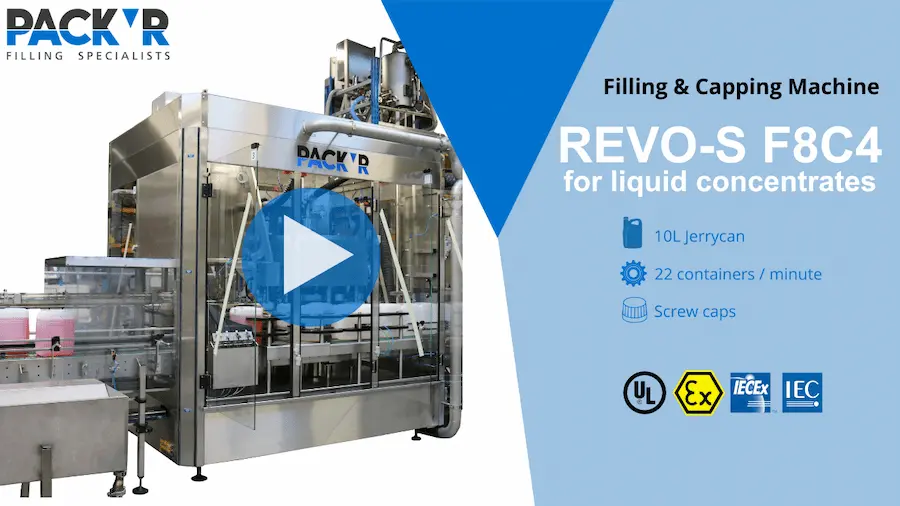In the world of manufacturing, safety and quality are paramount considerations. This is especially true in industries where hazardous materials are filled. As companies strive to meet stringent safety standards while maintaining efficiency, the adoption of ATEX- certified machinery has become increasingly prevalent, particularly in the filling machine market.
- What are the benefits of ATEX Certifications?
- How do I know if an equipment is designed for an ATEX area?
- How do you define an ATEX area?
- How PACK’R gets ATEX Certification for its liquid filling machine?
- Are PACK’R filling and capping machines EX-Proof certified for the North American market?
- Videos: 2 Examples of ATEX filling machines
ATEX, derived from the French “Atmosphères Explosibles,” is a certification that ensures packaging equipment such as Filler-Cappers or pallet drum filling equipments are designed and manufactured to operate safely in potentially explosive atmospheres. In the context of filling machine manufacturing, ATEX certified machines play a crucial role in safeguarding both operators and products.
For decades, PACK’R has been forefront in designing semi-automatic and fully automatic ATEX filling machines for flammable liquid products. Renowned for its commitment to quality and innovation, PACKR has established itself as a trusted leader in the field, delivering filling solutions that operate reliably in challenging & explosive environments. Whether PACKR filling machines for jerrycans or drums are used in chemical plants, agrochemical or food processing plants, they must also withstand exposure to potentially corrosive or abrasive and/or flammable materials.
PACK’R liquid filling machines are constructed with robust materials and feature specialized design elements (fume exhaust system on filling nozzles, grounding system) that minimize the likelihood of ignition sources coming into contact with flammable substances and products.
1. What are the benefits of ATEX Certifications?
- Enhanced Safety: ATEX-certified equipment ensures a higher level of safety, reducing the risk of explosions and protecting staff.
- Legal Compliance: Achieving certification demonstrates compliance with stringent safety standards and regulatory requirements.
- Operational efficiency
2. How do I know if an equipment is designed for an ATEX area?
Equipment, whether electrical or non-electrical (pneumatic, hydraulic, mechanical, etc.), installed in areas at risk of explosion, as well as protection systems, must be appropriate to the type of area concerned.
The equipment is identified by a specific marking consisting of letters and numbers of the following type:
- Equipment group (depending on location, I for mines or II for surface industries)
- Category (1, 2 or 3)
- Atmosphere type (G for gases/vapors or D for dusts)
- Ex explosion protection marking
- CE marking
- Notified body number
Example of a marking plate for a PACK’R automatic PULSA-S10 Filler Capper in ATEX Design
3. How do you define an ATEX area?
Hazardous locations are classified as ATEX areas. There are 6 areas (zones) based on frequency and duration of the presence of an explosive atmosphere:
Gas/vapor zone:
- Zone 0: atmosphere present permanently or for long periods during normal operation
- Zone 1: explosive atmosphere occasionally present during normal operation
- Zone 2: explosive atmosphere present accidentally in the event of a malfunction or for a short period.
Dust Zone:
- Zone 20: explosive atmosphere present permanently or for long periods during normal operation
- Zone 21: explosive atmosphere occasionally present during normal operation
- Zone 22: explosive atmosphere present accidentally in the event of malfunction or for short periods
4. How PACK'R gets ATEX Certification for its liquid filling machine?
- Identify Applicable Directive: Determine the relevant directive (2014/34/EU) and understand its requirements.
- Risk Assessment: Conduct a thorough risk assessment to identify explosive atmospheres and potential ignition sources (Electrical and non-electrical elements) according to ATEX Standards
- Hazardous Area Classification: Classify Filling & Capping equipment based on ATEX categories and zones to ensure proper usage in specific environments.
- Documentation: Prepare technical documentation demonstrating compliance with ATEX requirements.
- Testing and Assessment: Audit & Certification by a notified body
- CE Marking: Affix the marking, conformity based on unit verification
- Declaration of Conformity: Issue a Declaration of Conformity, declaring that PACKR filling and capping machine meets ATEX requirements
Example of PACK’R declaration of conformity
5. Are PACK'R filling and capping machines EX-Proof certified for the North American market?
ATEX certification is specific to the European Union and is not directly applicable in the United States.
Approving an Ex-Proof filling machine for use in America involves navigating different Standards and certification bodies.
Due to its strong presence on the US market through its American subsidiary in Atlanta, Georgia, USA, PACK’R filler-cappers for hazardous locations are compliant with the US Safety standards (HAZLOC Standards) and among others OSHA (Occupational Safety and Health Administration) and NFPA 70 (National Electrical Code NEC) regulations.
NEC Classifications differ from ATEX zones and are described as followed:
Class I, Division 1: Ignitable concentrations of flammable gases or vapors are present continuously or frequently
Class I, Division 2: Ignitable concentrations are not likely during normal operation but may occur under abnormal conditions
Groups: Further subdivided into groups (e.g. Group A, B, C, D) based on the specific hazardous substances present.
Certifying an explosion-proof filling machine for use in the US involves a detailed process of understanding standards, selecting a certification body (such as UL or QPS), preparing documentation, undergoing testing and ensuring proper installation following NEC guidelines.
Examples of PACK’R Liquid Filling Equipment in ATEX Environnement
Watch our video: Monobloc Filling and capping machine REVO-S:
Main REVO-S characteristics:
- Product: Liquid concentrates in the food industry
- Output: 22 containers per minute
- Containers: 10 L Jerrycan
Watch our video: Pallet drum semi-automatic Filling machine FLEXEO-P
Main FLEXEO-P characteristics:
- Product: solvent base paint
- Output: 40 drums per hour
- Containers: 200 L drums
Discover our complete range of semi-automatic and automatic filler capper.
Would you like to get more information from our Experts or discuss a project study, feel free to contact us sales@packr.com

Céline Leduc
Sales Executive with more than 15 years experience in the packaging industry






